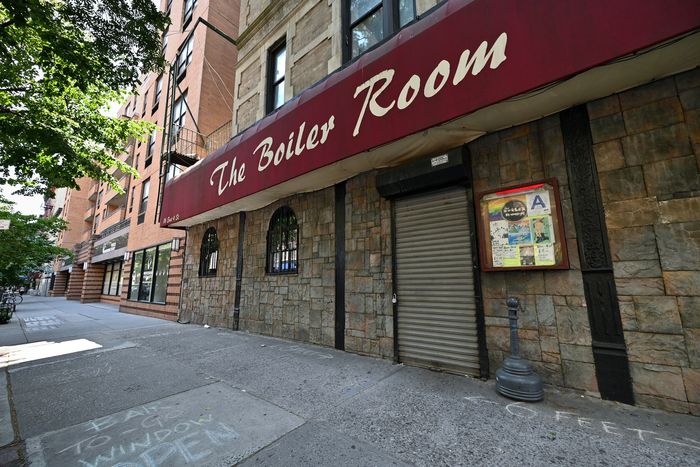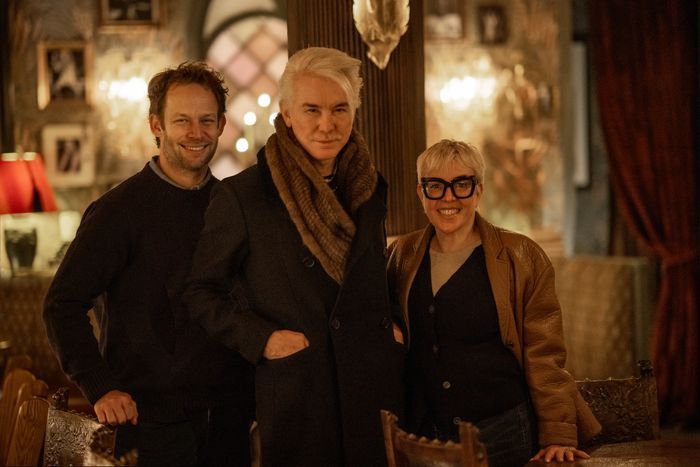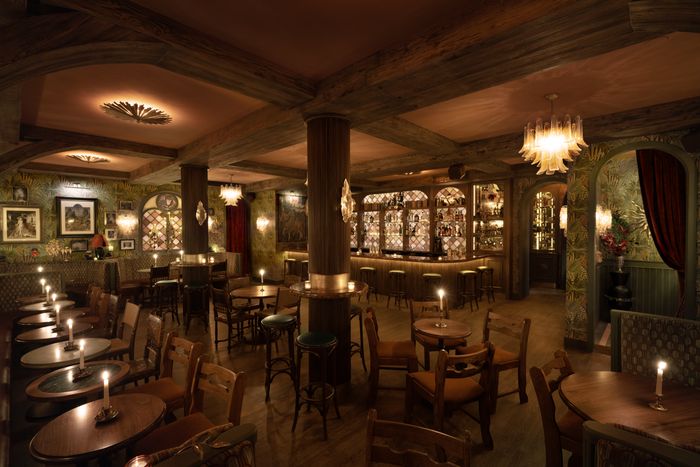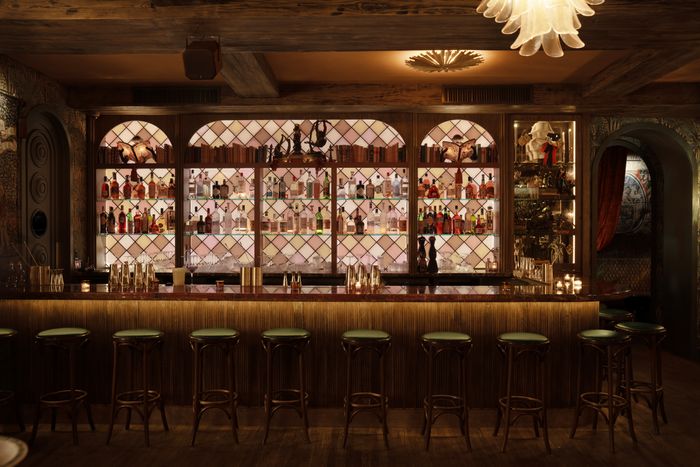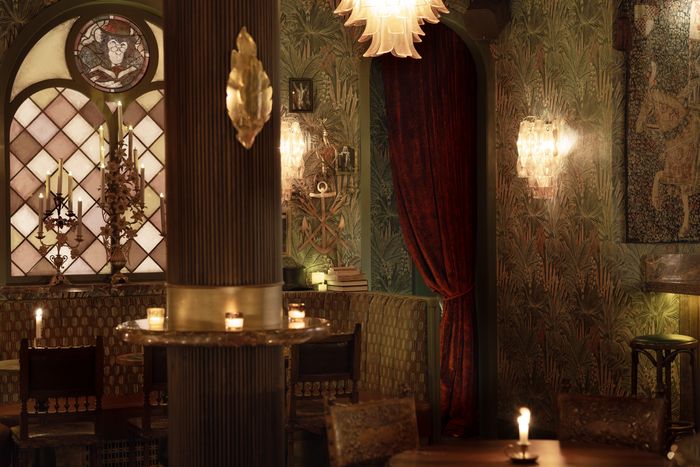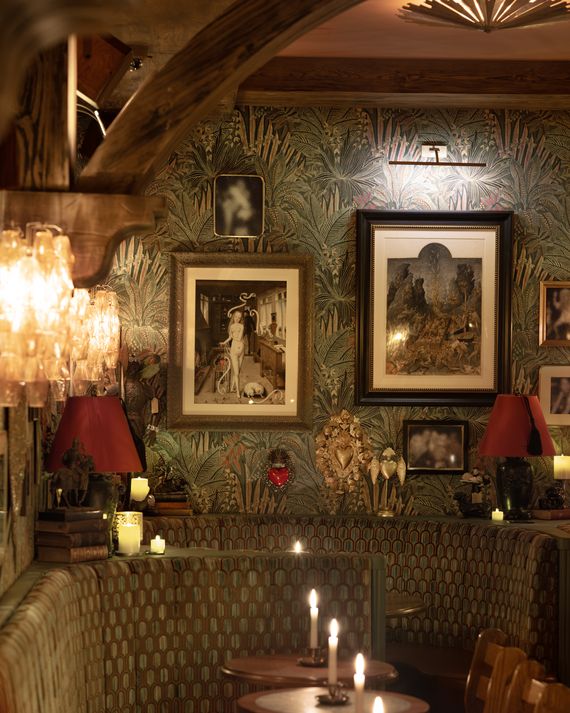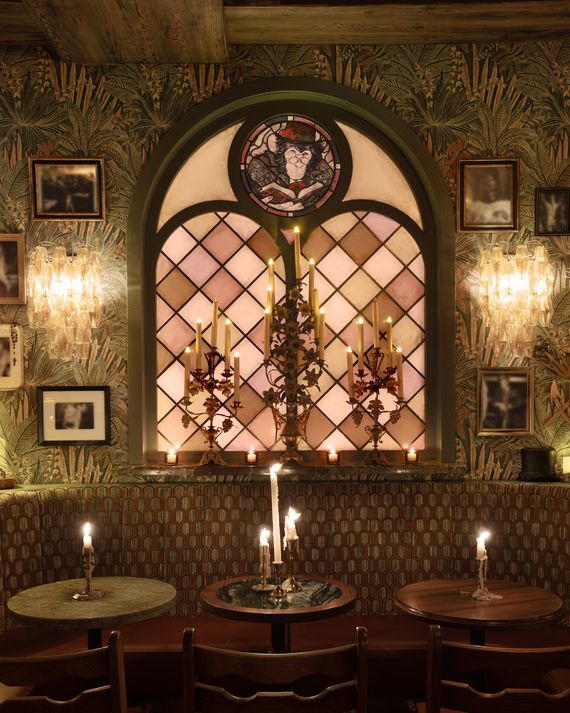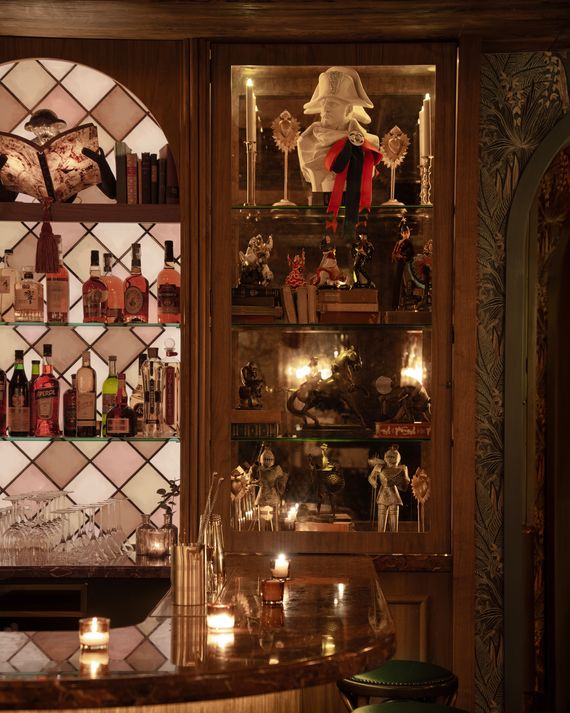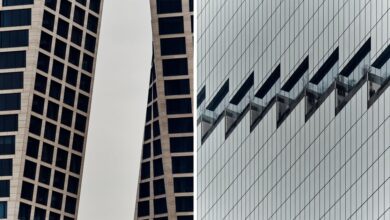Baz Luhrmann’s Production Designer Reinvents the Boiler Room
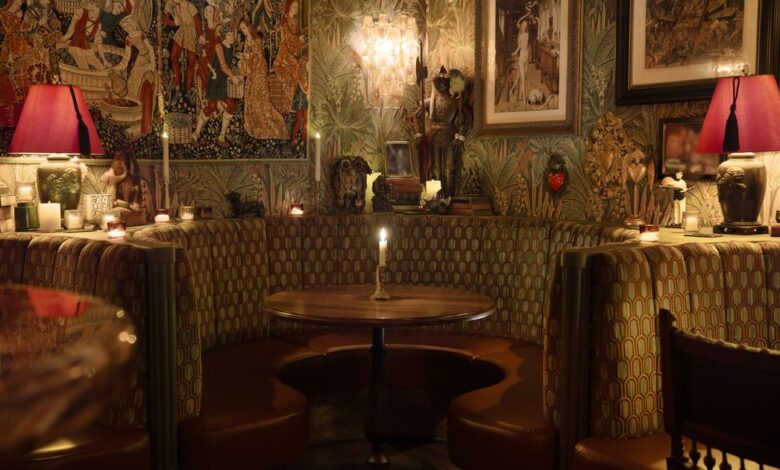
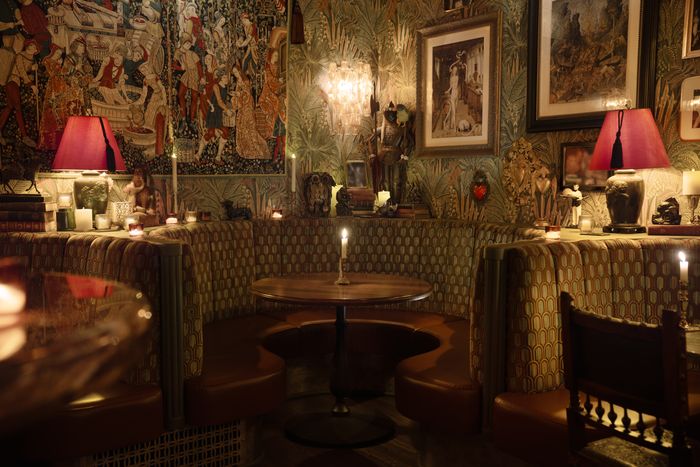
The corner booth. Note the print on the right of The Witch, a 15th-century painting that Catherine Martin learned about studying for an upcoming Baz Luhrmann film.
Photo: Emily Andrews
The Boiler Room was never a spot to go to for the décor. When it closed last April after 34 years over a rent dispute, it moved around the corner, and its shell was leased to Jon Neidich, the restaurateur behind scene-y spots like The Nines, Ray’s, and Le Crocodile. To remodel, he tapped two of his regulars — Baz Luhrmann and production designer Catherine Martin, who married in 1997 and have worked on Luhrmann’s films together, from Romeo + Juliet to Elvis. Martin, who also sells fabric, rugs, wallpaper, and décor through her eponymous line, had designed a Miami hotel but never a stand-alone bar. We chatted about opening Monsieur, filling the space with brass monkeys, 1970s party photos, and custom tapestries.
I assume you are busy and have to say no to a lot of design jobs. Did anything call out to you about this project?
When we were just considering working on the bar with Jon, we walked up and I said, “Baz, it has this weird medieval façade. How about that for synchronicity?” It just felt kind of right, like everything in our lives was moving in a similar direction. We were working on a Joan of Arc movie, and on a movie, we have to stick to the story. But for a bar, I thought I could explore what I was learning about medieval design in a fun, not self-conscious way.
The long-overlooked faux-medieval façade.
Photo: Dia Dipasupil/Getty Images
Was there anything else in the space?
Well, initially we were going to use the bones of the place: the brick wall, the existing floor, even the bar. But we needed to soundproof, and that work was quite extensive, and when we went to look at the bar, we found the floor was rotted and needed to be replaced. So we went from dressing something up to having a blank slate. And once the space was just a blank box, the one thing that had character was the façade.
Did you ever figure out why it has that odd façade? Fake stone with arched windows?
If I was to surmise it, someone in the 1960s, before Landmarks, was maybe inspired by the fact that the windows were arched — because they seem to be original. That became kind of the beginning of the story.
Neidich, Luhrmann, and Martin.
Photo: Emily Andrews
A story?
We always think of everything through narrative. And so does Jon, as a restaurateur. He always starts with Who is the mythical bar owner? What is their aim? What kind of people come here? What’s the history of the place? Baz calls hospitality “a Broadway show that never closes,” because every night you are creating an atmosphere and that’s quite intangible. So we started to make a fictional history based around a character we called Monsieur.
It almost sounds like Baz is giving you a script.
Yeah, absolutely. For a set to feel lived-in and real, you’ve got to imagine the lives of the characters within the space. Visconti filled every closet in The Leopard because he believed that that is how you create an immaculate reality. Jon has a commitment to that same kind of immaculate reality in terms of hospitality. He goes to the space as it’s being developed and tries to live the life of his customer, writing a whole narrative by asking, Who am I? Where am I going? What do I want? How am I going to be greeted at the door? He wants to know what feels natural for the guest, and how the space is going to work at different times.
The gut renovation added beams over the ceiling and moved the bartop.
Photo: Emily Andrews
So he is almost thinking of the viewer of a movie. And you’re imagining the movie.
Yes. With Monsieur, it was about a guy who’d lived for centuries, sort of a bar-owning Zelig of the ages, based on Baz Luhrmann and his opus — although this Monsieur has lived for centuries, through the ages. The question became, How do you start with an old medieval interior and think about somebody who’s lived there since the 13th century? How do you imbue the space with a sense of history, not only of the East Village, but of this person? And that’s how collectively the three of us started talking about a medieval mashup with the kind of late ’60s, ’70s, early ’80s of the East Village.
Seventies lighting over a vaguely medieval stained-glass-backed bar.
Photo: Emily Andrews
And you start with medieval, this period you’ve been studying already.
Yes, and we do have a few Joan of Arc statues in there. But it was really fascinating to use the bar project to think about the popular ways that people have connected to medievalism. So many periods had medieval revivalist moments, whether it’s Gothic Revival in the 1830s that reappears in the late 1850s. Even in the 1920s, no one ever thinks about Art Deco as Gothic Revival, but if you think of Spanish Mission furniture, that certainly links to those Gothic motifs. And then you’ve got Brutalism in the ’60s and ’70s, and every “ye olde” bar and pub has a couple of shields and cross swords. And we learned about this aesthetic called Medieval Psychedelia — Bosch wasn’t the only one with crazy Surrealist images. So we mix and match. You can see it in the chairs: We have some Jacobean Revivalist chairs, some Brutalist Razorback chairs, which are mid-century.
Photo: Emily Andrews
How did you source some of these objects? Was there something that was really hard to find?
I doomscroll. I bought every single object either on Chairish or 1stDibs or Etsy. And then you start going down these rabbit holes. You can get some whacked-out tapestries. And there was a huge tapestry, medieval revival, that I loved. But, this is probably very unglamorous to say, we needed to make our dollar stretch but still feel authentic and look good. One of my professors at design school said, “You should always mix high and low and confuse the eye.” So I have a 1950s tapestry that’s French that I bought off the French equivalent of Facebook Marketplace, Le Bon Coin. And then the contemporary reproduction tapestries we had woven. I bought the rights to stock photos I found online, and got an American weaver who programs designs on a computer.
The Witch in the center of a display over the corner banquette.
Photo: Emily Andrews
Do you have a favorite piece?
The one that really strikes me is a print over the corner booth. It’s from the 15th century by an anonymous artist, and it’s called The Witch. It shows a naked woman wearing a pair of what looked like Balenciaga mules and a man who I imagine is looking at her while she’s making all these ribbons dance. To me, this shows the kind of mystical, bizarre, side of the medieval period, and also how engaged women were in society and how much power they had — at least if you compare that era to the Protestant Reformation, when there’s a real Handmaid’s Tale moment, where women were sent back to the home, their goods were repossessed.
Wow. What did you learn about that you didn’t know existed?
There are foundries in America that pour things to order and have a whole section devoted to erotic sculpture. I was like, Really? People buy giant bronze penises to put on their coffee table? To each their own. And I was surprised by the number of bronze monkey statues that are really good that you can find online.
Let’s talk about the monkeys. There are monkeys in the windows?
Yes, we put all of the stained glass in, custom, and created the character of Thibault that is a chimp, a familiar of Monsieur — a reflection of how Monsieur sees himself. He’s thinking about, How distant am I from an animal? What makes me a person?
Photo: Emily Andrews
Why is the monkey reading The Master and Margarita?
Well, it’s a book about a struggle to avoid making. It’s a literary work that keeps pursuing him. So I think it’s just a little nod to the fact that that something is haunting him. But Monsieur is also a reader, so there are huge amounts of books. For me, that’s about the Enlightenment era of reading and expanding your horizons, which shows an openness.
That feels appropriate for the old Boiler Room space. I keep thinking about how you would’ve been criticized for stripping history out of there, but instead you spent the whole process adding more history in layers.
We were conscious of that. You know when you go to an old Italian restaurant and there’ll be thousands of photos of random people who some of you recognize, some you don’t, all signed on the wall? It gives you this sense that the space is anchored in history, that there’ve been friendships made here and marriage proposals and lives have been destroyed and lives have been built all in this space. We had thought about every kind of photo, and we hadn’t found photos that felt like they were taken by someone on the dance floor in the middle of the moment. At the 11th hour, Jon remembered that his ex-wife’s best friend’s father was Dustin Pittman. We ran uptown to buy the book and just started saying, “This is right.” His photos are extraordinary because they’re really inside the moment. So you have a real sense of Monsieur being a person with friends and a history in this space over a long period of time.
Then the minute I met Dustin, I saw that he was part of the mystique of Monsieur, too. He’s an extraordinary-looking man — tall and rangy and really coolly dressed. You really believe you’re meeting a cross between all those sort of celebrities like Iggy Pop and Mick Jagger. He has that kind of swagger.
Did Jon Neidich contribute other ideas?
Jon is a lighting obsessive. There’s a combination of reproduction, mid-century, and ’70s lights and antique lights bought off the internet. We got some beautiful brass Brutalist sconces on the columns, but they were too small in scale, so we then had back plates made for them that increased the scale of the lights. And Jon found all of the table lamps on the back of the banquette — a set of 12, I think, from a big New York hotel. I was suggesting a much more kind of Baroque shade. And he said, “I think the lamps should all be wearing fez hats.” So we had all of the lampshades made to look like fez hats to link back to Thibault, the monkey.
A Napoleon bust with a dashing ribbon watches over the bar.
Photo: Emily Andrews
Did Baz give you notes on the décor, like he would on a movie?
He said to me, “You need to make sure that people know that we’re being playful with the bust of Napoleon, that we are being playful with the bust of Alexander. This isn’t serious. You need to find a quirky queerness that makes these busts acceptable.” So our Alexander wears earrings.
A set can be like a little dictatorship, but a bar is alive. Is it annoying to see your pieces moved around?
No — I love when that happens. The space will only improve with the interaction of humans. It will gain a pattern that will give it life and texture and history and relevance.
This interview has been edited and condensed for clarity.

